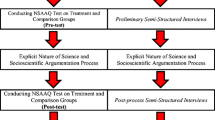Abstract
Constructing explanations and participating in argumentative discourse are seen as essential practices of scientific inquiry. The objective of this study was to explore the elements and origins of pre-service secondary science teachers’ alternative conceptions of tidal phenomena based on the elements used in Toulmin’s Argument Model through qualitative research. The data were collected from three pre-service secondary school teachers (D.-K. University, Teachers’ Colleges, junior and senior) in the Republic of Korea using a variety of qualitative research methods. We present three pre-service teachers as examples of 20 pre-service teachers for determining each pre-service teacher whether the pattern of his/her responses to all of the questions investigating a given concept can be explained by the consistent use of components of argument. The results of this study showed “the model with the Earth’s center at rest” backing their warrants as an element of Toulmin’s Argument Model. As a result, science educators must explicitly address these presuppositions or implicit beliefs and must help the students form links between their everyday experiences and scientific knowledge. Therefore, educators must be aware of the influence of students’ presuppositions and must use acceptable scientific concepts (the center of mass of the Earth–Moon system) based on argumentation to guide their construction of scientific concepts.
Similar content being viewed by others
References
Benson, H. (1996). University physics (Revth ed.). New York: Wiley.
Cros, D., Chastrette, M. & Fayol, M. (1987). Conceptions of second year university students of some fundamental notions of chemistry. International Journal of Science Education, 10, 331–336.
Driver, R., Guesne, E. & Tiberghien, A. (1985). Children’s ideas and the learning of science. In R. Driver, E. Guesne & A. Tiberghien (Eds.), Children’s ideas in science (pp. 1–9). Milton Keynes: Open University Press.
Feldman, A. (2000). Decision making in the practical domain: a model of practical conceptual change. Science Education, 84, 606–623.
Ford, M. J. & Wargo, B. M. (2012). Dialogic framing of scientific content for conceptual and epistemic understanding. Science Education, 96, 369–391.
Gable, D. & Bunce, D. (1984). Research on problem solving in chemistry. In D. Gabel (Ed.), Handbook of research on science teaching and learning (pp. 301–326). New York: Macmillan.
Lee, S. K. (2012). Improving science teachers’ teaching professionism: research and practice (Korean Language). Seoul: Kyoyookbook.
Lortie, D. (2002). Schoolteacher: a sociological study (2nd ed.). Chicago: The University of Chicago Press.
Lythcott, J. & Duschl, R. (1990). Qualitative research: from methods to conclusions. Science Education, 74(4), 445–460.
Oh, J.-Y. & Kim, Y. S. (2006). Preservice elementary teacher mental models about astronomical phenomena: seasons and moon phases. Journal of Korean Association for Research in Science, 26, 68–87.
Oh, J.-Y. & Kim, Y. S. (2009). The advocation and educational applications about Toulmin’s argument model. The Journal of Pan-Korean Philosophical Society, 55, 379–425.
Rea-Ramirez, M. A. & Núñez-Oviedo, M. C. (2008). Role of discrepant questioning leading to model element modification. In J. J. Clement & M. A. Rea-Ramirez (Eds.), Model based learning and instruction in science (pp. 195–213). New York: Springer.
Rieke, R. & Sillars, M. O. (2005). Argumentation and decision making process (2nd ed.). Glenview, IL: Scott, Foresman and Company.
Schwarz, B. B., Neuman, Y., Gil, J. & Ilya, M. (2003). Construction of collective and individual knowledge in argumentation activity. Journal of the Learning Sciences, 12(2).
Thompson, C. (1989). Discrepant events: what happens to those who watch? School Science and Mathematics, 89(1), 26–27.
Toulmin, S. (1958). The use of argument. Cambridge: Cambridge University Press.
Verheij, B. (2005). Evaluating arguments based on Toulmin’s scheme. Argumentation, 19, 347–371.
Author information
Authors and Affiliations
Corresponding author
Electronic supplementary material
Below is the link to the electronic supplementary material.
ESM 1
(DOC 108 kb)
Rights and permissions
About this article
Cite this article
Oh, JY. UNDERSTANDING THE ALTERNATIVE CONCEPTIONS OF PRE-SERVICE SECONDARY SCIENCE TEACHERS ABOUT TIDAL PHENOMENA BASED ON TOULMIN’S ARGUMENTATION. Int J of Sci and Math Educ 12, 353–370 (2014). https://doi.org/10.1007/s10763-013-9403-2
Received:
Accepted:
Published:
Issue Date:
DOI: https://doi.org/10.1007/s10763-013-9403-2




